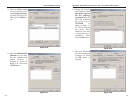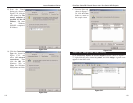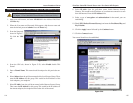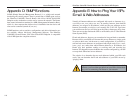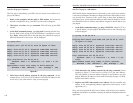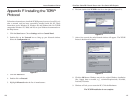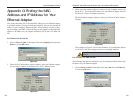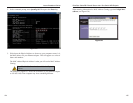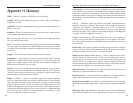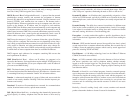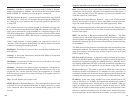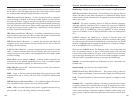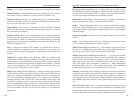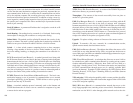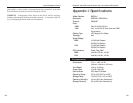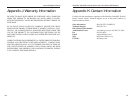
EtherFast
®
Cable/DSL Firewall Router with 4-Port Switch/VPN Endpoint
Cable Modem - A device that connects a computer to the cable television net-
work, which in turn connects to the Internet. Once connected, cable modem
users have a continuous connection to the Internet. Cable modems feature
asymmetric transfer rates: around 36 Mbps downstream (from the Internet to
the computer), and from 200 Kbps to 2 Mbps upstream (from the computer to
the Internet).
CAT 5 - ANSI/EIA (American National Standards Institute/Electronic
Industries Association) Standard 568 is one of several standards that specify
"categories" (the singular is commonly referred to as "CAT") of twisted pair
cabling systems (wires, junctions, and connectors) in terms of the data rates
that they can sustain. CAT 5 cable has a maximum throughput of 100 Mbps and
is usually utilized for 100BaseTX networks.
Cookie - Data created by a Web server that is stored on a user's computer. It
provides a way for the Web site to keep track of a user's patterns and prefer-
ences and, with the cooperation of the Web browser, to store them on the user's
own hard disk.
Data Packet - One frame in a packet-switched message. Most data communi-
cations is based on dividing the transmitted message into packets. For example,
an Ethernet packet can be from 64 to 1518 bytes in length.
DDNS (Dynamic Domain Name System) - Allows a network device with a
dynamic Internet IP address to have a fixed host and domain name, such as
myhostname.mydomainname.com. It is useful when you are hosting your own
website, FTP server, or other server behind a router, so people can find your
site no matter how often the Internet IP address changes. Using DDNS requires
registering with a DDNS service provider on the Internet.
Default Gateway - The routing device used to forward all traffic that is not
addressed to a station within the local subnet.
Denial of Service - A protocol that directs the network to no longer respond to
requests that might arise as the result of a Denial of Service attack.
Denial of Service Attack - An assault on a network that floods it with so many
additional requests that regular traffic is either slowed or completely interrupt-
ed.
DES (Digital Encryption Standard) - Encryption used for data communication
where both the sender and receiver must know the same secret key, used to
127
Instant Broadband
®
Series
126
Appendix H: Glossary
3DES - 3DES is a variation on DES that uses a 168-bit key.
Adapter - Printed circuit board that plugs into a PC to add to capabilities or
connectivity to a PC.
AppleTalk - An Apple Computer networking system that supports Apple's pro-
prietary local talk.
Backbone - The part of a network that connects most of the systems and net-
works together and handles the most data.
Bit - A binary digit. The value - 0 or 1-used in the binary numbering system.
Also, the smallest form of data.
Boot - To cause the computer to start executing instructions. Personal comput-
ers contain built-in instructions in a ROM chip that are automatically executed
on startup. These instructions search for the operating system, load it and pass
control to it.
Bridge - A device that interconnects different networks together.
Broadband - A data-transmission scheme in which multiple signals share the
bandwidth of a medium. This allows the transmission of voice, data and video
signals over a single medium. Cable television uses broadband techniques to
deliver dozens of channels over one cable.
Browser - A browser is an application program that provides a way to look at
and interact with all the information on the World Wide Web or PC. The word
"browser" seems to have originated prior to the Web as a generic term for user
interfaces that let you browse text files online.
Buffer - A buffer is a shared or assigned memory area used by hardware
devices or program processes that operate at different speeds or with different
sets of priorities. The buffer allows each device or process to operate without
being held up by the other. In order for a buffer to be effective, the size of the
buffer and the algorithms for moving data into and out of the buffer need to be
considered by the buffer designer. Like a cache, a buffer is a "midpoint holding
place" but exists not so much to accelerate the speed of an activity as to sup-
port the coordination of separate activities.



